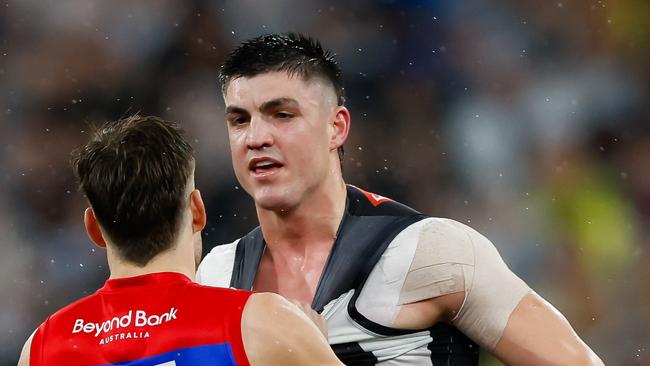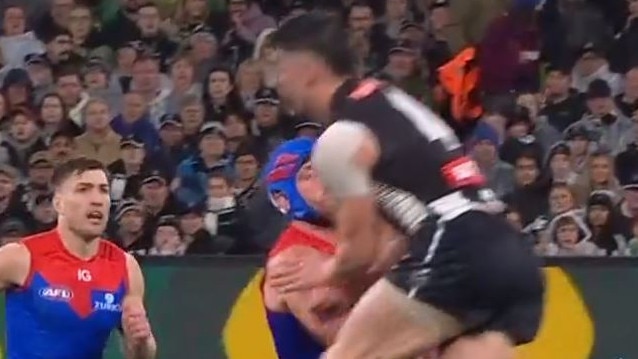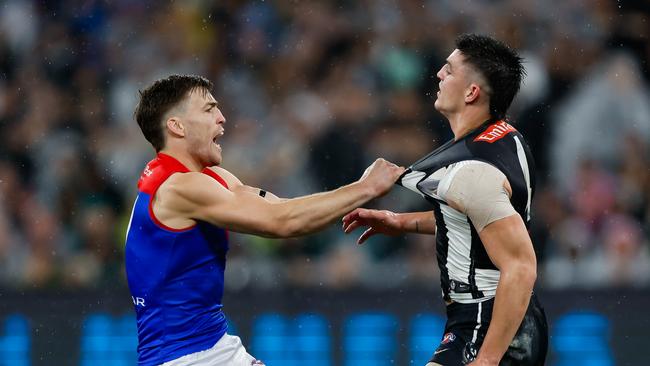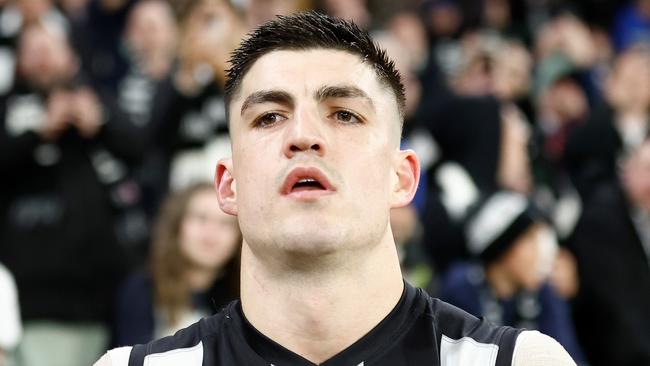Brayden Maynard tribunal: How monster four-hour hearing played out
Brayden Maynard’s split-second decision to jump was examined frame by frame for longer than the qualifying final. This is how an associate professor saved the Collingwood star.

AFL
Don't miss out on the headlines from AFL. Followed categories will be added to My News.
For all of the neurological and scientific advancements on concussion it was an associate professor who ultimately saved Brayden Maynard’s premiership dream.
You had to wonder what doctors caring for Angus Brayshaw and analysing his most recent brain scans made of the tribunal’s not-guilty verdict on Tuesday night.
The anger from the Brayshaw family has barely subsided.
They want the AFL to appeal the decision in what would be a final attempt to smother Maynard’s September hopes.
This was the tribunal hearing of the century and the public mood seemed to swing like a pendulum.
The flinch reaction was it was a football accident. As time progressed the big picture – preventing brain injuries – seemed to become more important.

But five days of emotion that seemed to build exponentially was drained on the stroke of 4pm when the legal eagles took charge.
Suddenly the explosive preamble that included Maynard’s soured visit to Brayshaw’s house carrying wine and flowers, and an apologetical phone call to Brayshaw’s mum, Debra, that went down similarly was all irrelevant.
The emotion also drained from Maynard, who sat alone looking stony-faced for hours.
Maynard was understandably fidgety.
He scratched his chest, rotated a toy football between hands and sipped from a water bottle as the same evidence was examined over and over and over again.
Maynard spent 26 minutes in the hot seat answering technical questions from the suits representing the AFL (Andrew Woods), Ben Ihle (Collingwood) and tribunal chairman Jeff Gleeson.
By the time Gleeson got to Maynard he was clearly over it all.
“Can you hear me?” Gleeson asked.
“Yes, mate,” Maynard responded.
Little did he know at the time that a verdict would be another four hours away.
It was the split-second decision to jump that was examined frame by frame for longer than the qualifying final.
Maynard revealed he actually did smother the ball, getting a fingertip to the Sherrin.

He said Brayshaw moved towards him and Ihle later argued that if car A veers into Car B’s lane then car B cannot be blamed for a crash.
The AFL argued Maynard had to ask himself a question.
“Is the thing that I’m about to do going to risk the safety of the other player?” Woods said.
“Unlike the ancient game of AFL football, there are times in the modern game where you do have to pull your punches.”
Australian Catholic University’s biomechanics and neuroscience specialist Michael Cole lodged his evidence – answers to eight questions that referenced astronomer Galileo and physicist Isaac Newton – long before Tuesday’s tribunal hearing.
Cole logged on to the hearing at 4.56pm and was put on hold for 15 minutes.
Fortunately, breakthroughs from Galileo and Newton roughly 400 years ago weren’t referenced when Cole was summoned.
Maynard looked cross, but as Cole was cross-examined, that expression should’ve started to fade.
Cole said once Maynard was airborne a collision with Melbourne’s Brayshaw was inevitable.
“Once he’s in flight he’s basically a projectile … a frisbee with legs,” Cole declared.
It was noted the average human reaction’s time was 200 to 250 milliseconds.
But that was in a “non-dynamic laboratory-controlled environment”.
What about on an AFL field? Athletes are 20-25 per cent faster but Cole said Maynard would’ve had no more than 400 milliseconds to react on a football ground.
There were also the possibility of wildcards. How did Maynard sleep last Wednesday night? Was he mentally fatigued?

There were wildcards everywhere.
Tribunal jury regulars Stewart Loewe, Shane Wakelin and Jason Johnson were replaced by Darren Gasper and Scott Stevens.
Would Wakelin and Johnson – who presided over Jack Martin’s case instead – have reached the same verdict as Gasper and Stevens when nobody else in the country seemed to agree on this one?
The field umpire paid a free kick on the spot and Match Review Officer Michael Christian deemed it a football accident the following day.
New AFL football boss Laure Kane and several AFL executives disagreed with their MRO and overruled Christian.
Past and contemporary players argued feverishly for Maynard to be banned and freed.
A Herald Sun poll was split 53-47 in the AFL’s favour from 6000 readers.
Ultimately it was Cole who cleared the Collingwood star.
“We accept the evidence of professor Cole that he did not believe that Maynard’s body position at the time of impact can be considered part of any conscious decision,” Gleeson said as he read the not-guilty verdict.
“We find that Professor Cole’s evidence is consistent with the time intervals that were introduced into evidence and consistent with our repeated viewing of the video evidence from numerous angles at normal speed.
“In order for it to be concluded that he engaged in the act of bumping it would be necessary to find that he formed that intention when in mid-air at approximately at the apex of his leap.
“We accept the evidence of Professor Cole as being consistent with a common sense viewing of the video evidence.
“Maynard had no time to form that intention. The charge is dismissed.”
More Coverage
Originally published as Brayden Maynard tribunal: How monster four-hour hearing played out




